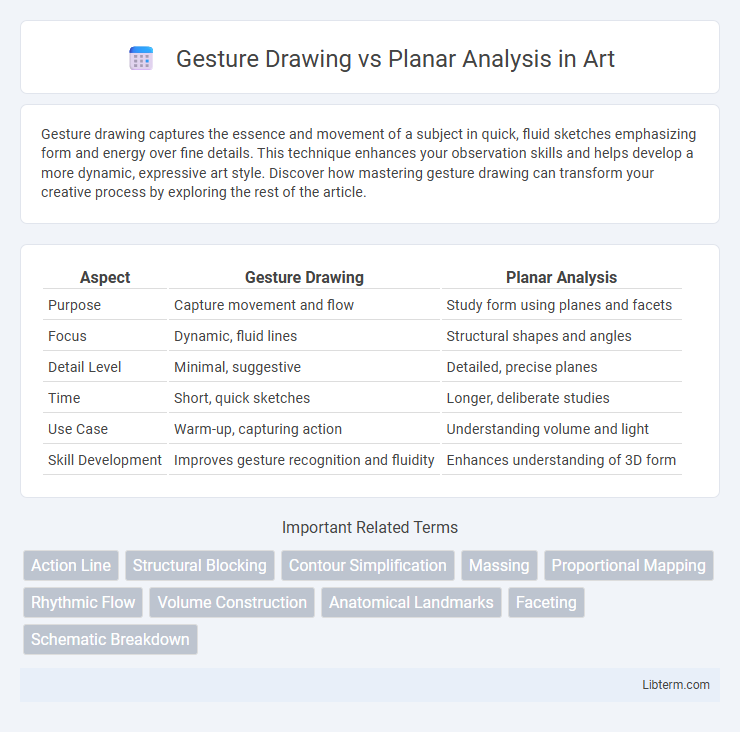Gesture drawing captures the essence and movement of a subject in quick, fluid sketches emphasizing form and energy over fine details. This technique enhances your observation skills and helps develop a more dynamic, expressive art style. Discover how mastering gesture drawing can transform your creative process by exploring the rest of the article.
Table of Comparison
| Aspect | Gesture Drawing | Planar Analysis |
|---|---|---|
| Purpose | Capture movement and flow | Study form using planes and facets |
| Focus | Dynamic, fluid lines | Structural shapes and angles |
| Detail Level | Minimal, suggestive | Detailed, precise planes |
| Time | Short, quick sketches | Longer, deliberate studies |
| Use Case | Warm-up, capturing action | Understanding volume and light |
| Skill Development | Improves gesture recognition and fluidity | Enhances understanding of 3D form |
Introduction to Gesture Drawing and Planar Analysis
Gesture drawing captures the fluidity and movement of a subject, emphasizing the essence and energy rather than detailed accuracy, making it essential for mastering dynamic poses. Planar analysis breaks down complex forms into flat planes, helping artists understand light, shadow, and structure by simplifying anatomy into geometric shapes. Combining gesture drawing with planar analysis improves figure drawing by integrating expressive motion with solid form comprehension.
Defining Gesture Drawing
Gesture drawing captures the essence and movement of a subject through quick, expressive lines that emphasize fluidity and dynamic poses. It focuses on the overall action rather than detailed anatomy, allowing artists to convey energy and rhythm in a minimal amount of time. This technique contrasts with planar analysis, which breaks down forms into geometric shapes to understand structure and volume more precisely.
Understanding Planar Analysis
Planar analysis breaks down complex anatomical forms into simplified geometric planes, enhancing the understanding of volume, structure, and light interaction in figure drawing. It enables artists to visualize the three-dimensional shapes beneath the surface, facilitating accurate shading and perspective. Compared to gesture drawing, which captures movement and flow, planar analysis focuses on the underlying form, making it essential for mastering realistic rendering and spatial relationships.
Key Differences Between Gesture and Planar Approaches
Gesture drawing emphasizes capturing the fluidity and movement of a subject with quick, expressive lines to convey energy and action. Planar analysis focuses on breaking down complex forms into flat planes to understand structure, light, and shadow for accurate volume representation. Gesture prioritizes dynamic motion and spontaneity, while planar analysis stresses geometric construction and spatial relationships.
Benefits of Gesture Drawing for Artists
Gesture drawing enhances artists' ability to capture movement and fluidity quickly, fostering a deeper understanding of form and anatomy in dynamic poses. This practice sharpens observational skills and builds confidence by encouraging expressive, spontaneous sketches that convey emotion and energy. Regular gesture drawing boosts hand-eye coordination and helps artists develop a more intuitive approach to figure drawing, improving overall artistic agility.
Advantages of Planar Analysis in Art
Planar analysis enhances an artist's understanding of three-dimensional forms by breaking complex shapes into simplified geometric planes, improving accuracy in depicting volume and light. This method aids in mastering shading techniques and creating more realistic renderings by clarifying spatial relationships and surface orientation. Planar analysis also fosters better structural comprehension compared to gesture drawing, which primarily captures movement and rhythm.
Techniques for Gesture Drawing
Gesture drawing techniques emphasize capturing the model's movement and energy through quick, fluid strokes that outline the body's dynamic poses. Artists use loose, continuous lines focusing on rhythm, proportion, and flow rather than detailed anatomy to convey motion effectively. This method contrasts with planar analysis, which dissects the body's surfaces and planes to define structure more precisely.
Methods for Planar Analysis
Planar analysis methods involve breaking down complex forms into simplified geometric planes to better understand volume, structure, and light interaction. Artists use angular shapes to capture the three-dimensionality of subjects, emphasizing edges and flat surfaces rather than continuous curves. This approach aids in developing accurate proportions and spatial relationships, enhancing the foundation for realistic shading and rendering.
When to Use Gesture vs Planar Analysis
Gesture drawing is essential for capturing the dynamic movement and overall flow of a figure, making it ideal during initial stages of sketching or life drawing sessions. Planar analysis is more effective when refining the structure, form, and spatial relationships of complex subjects to achieve accurate proportions and lighting. Use gesture drawing to prioritize motion and energy, and planar analysis to emphasize volume and surface orientation.
Combining Both Approaches for Artistic Growth
Combining gesture drawing and planar analysis enhances artistic growth by balancing fluidity with structural understanding, allowing artists to capture dynamic movement while maintaining accurate form. Gesture drawing emphasizes rapid, expressive lines to convey motion and energy, whereas planar analysis breaks down complex forms into simplified geometric planes for spatial clarity. Integrating both methods develops a comprehensive skill set that improves both anatomical accuracy and expressive creativity in figure drawing.
Gesture Drawing Infographic

 libterm.com
libterm.com